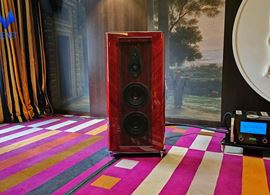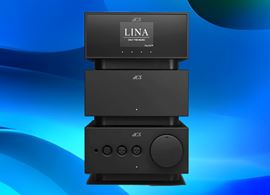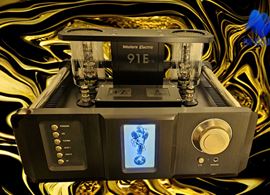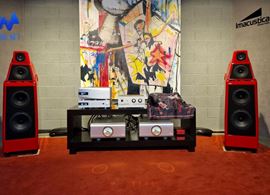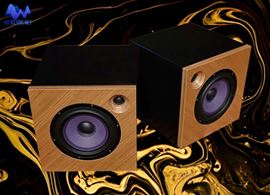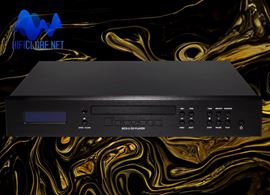Embora neste caso, o artigo de Ken seja tudo menos encomiástico, a verdade é que, tal como os outros, segue uma linha paralela de pensamento. E pour cause, pelo menos neste caso, Ken deve ter lido o meu artigo antes de eu ler o dele...
NAGRA PYRAMID MONOBLOCKS

Quem analisar com atenção o meu artigo em 3 partes intitulado «The Mystery of the Pyramids» (os que ainda não leram podem fazê-lo agora) não vai deixar de notar as coincidências de opinião (e naturais divergências: no seu estilo «Sousa Tavares», Ken é bem menos meigo do que eu na apreciação do PMA).

Abri o meu artigo com uma longa dissertação irónica sobre amplificadores de Classe D e fontes comutadas (switching mode power supplies) que era uma crítica implícita ao facto de a Nagra negar as evidências. Bastava olhar para a fotografia do interior do aparelho: o Nagra PMA utiliza uma fonte comutada, como Paul Miller afirma. Mas como a Nagra me declarou por escrito que não, quem sou eu, que nasci em Alcabideche, para os contrariar?
Contudo, pelo sim pelo não, como quem não quer a coisa, forneci toda a informação necessária aos leitores sobre Classe D, fontes comutadas e PFC (power factor correction). Não que isso seja um mal em si próprio, a legislação europeia aponta cada vez mais para este tipo de PSU. Aliás, os leitores mais atentos devem ter reparado que na descrição da PFC acrescentei entre parênteses: (which does not preclude the use of a switch mode to control the ON/OFF switching). Ou como quem diz diplomaticamente: uma coisa não invalida a outra.
O meu título: «The Mystery of The Pyramids»; o da Hifi News: «Pyramid Power, Nagra's mysterious amplifier».
Não há coincidências?...
Escrevi eu:
«Seen from the back they look like a «tin man's amp...»
E depois:
«Bass was tight and articulate, extending deep into the nether octaves while at the same time revealing an uncanny grip over the speakers. But it lacked the poise and wallop of the resident Krell FPB 400cx.»
E também:
«What little grain there was, I attributed... to the ordeal of having to drive the ML electrostatic panels which have been known to lower the impedance unduly as frequency rises.»
«The PMA bass was leaner although it also possessed a strong sense of drive and pace. And yet, one feels that somehow it doesn't offer that same sensation of unlimited power which is the trademark of Krell. Most of the time I refrained myself from pushing the PMAs to the theoretical limits: I could feel the stress creeping in, arguably in the form of a slight audible compression whenever I tried to do that».
E ainda:
«With classical music recorded in natural acoustics, I wasn't surprised to find the «PMA's dryness» was also apparent in the «atmosphere», the «air» surrounding and enveloping the musicians...»
Escreveu Miller:
«The MPA meets its 200W specification delivering a full 230W/8ohms, but shows barely any increase at all under dynamic conditions...this is a little low for a 200 watter...»
«There is a steady increase in distortion at higher frequencies...when driving lower impedance loads...»
Escreveu Ken:
«The flimsy pyramid section certainly doesn't suggest manufacture by Nagra...»
«At first I was too easily seduced by the power...But, from the get-go, it seemed lean - too lean...»
«the X-200s seem more powerful...the X-200s isn't as accurate, but it's helluva lot warmer...it's brittle and edgy...»
«It's bass was solid and taut, but it sounded artificial, even when the source was wholly acoustic... large-scale percussion was paper-y»
É um facto incontestável que eu optei também, como é meu apanágio - e obrigação moral e profissional - por realçar os aspectos positivos do PMA, enquanto Ken nem se deu ao trabalho, talvez porque a Nagra não cumpriu com ele quanto à prometida exclusividade. E eu digo isto porque foi o mesmo Ken Kessler que na Stereophile de Janeiro 05, reportando sobre a TOP Milan, escreveu o seguinte sobre os mesmissimos Nagra PMA:
«Nagra's PMA Pyramid monoblock power amplifiers looked terrific and sounded sensational. Each of them puts out 200W and simply oozes Swiss build quality».
O que se terá passado para acontecer esta viragem de 180 graus: o facto de eu me ter adiantado?...
Mas é inegável que ouvimos o «mesmo» amplificador - temos, aliás, uma empatia acústica e pessoal há muitos anos.
De tal modo que se o meu artigo tivesse sido publicado posteriormente teria caído o Carmo e a Trindade...
Leia-se ainda a opinião de Ken, quase totalmente coincidente com a minha, sobre o Nagra PL-L, tanto mais curiosa quanto Ken utilizou, tal como eu, o McIntosh C2200 como termo de comparação.
Escrevi eu quanto ao «efeito» do PL-L no som do PMA:
«Now you could walk into the soundstage like you do «into» a holographic picture after looking attentively at it for a while ... Microdynamics improved, as did all the other sound parameters: citius, altius fortius ... Bass got rounder, the «mids» became more tactile, the highs remained vivid yet luscious».
« The PL-L put that same glowing smile on the PMA's face. And mine too. It didn't change its character, mind you, neither did it invalidate what was written before».
Escreveu ele referindo-se ao efeito PL-L o som PMA:
«What a pre-amp! A vast soundstage carved out a huge playground for big band sessions. What the PL-L does that I found frightening in its veracity was to convey the punch and power of loud acoustic instruments».
«...the PL-L could ameliorate it only so far».
Nota: os leitores podem ler os artigos integrais seguindo os Artigos Relacionados abaixo (Partes 1, 2 e 3) e na revista Hifi News March 2005 pg 18-23
NAGRA PYRAMID MONOBLOCKS

Quem analisar com atenção o meu artigo em 3 partes intitulado «The Mystery of the Pyramids» (os que ainda não leram podem fazê-lo agora) não vai deixar de notar as coincidências de opinião (e naturais divergências: no seu estilo «Sousa Tavares», Ken é bem menos meigo do que eu na apreciação do PMA).

Abri o meu artigo com uma longa dissertação irónica sobre amplificadores de Classe D e fontes comutadas (switching mode power supplies) que era uma crítica implícita ao facto de a Nagra negar as evidências. Bastava olhar para a fotografia do interior do aparelho: o Nagra PMA utiliza uma fonte comutada, como Paul Miller afirma. Mas como a Nagra me declarou por escrito que não, quem sou eu, que nasci em Alcabideche, para os contrariar?
Contudo, pelo sim pelo não, como quem não quer a coisa, forneci toda a informação necessária aos leitores sobre Classe D, fontes comutadas e PFC (power factor correction). Não que isso seja um mal em si próprio, a legislação europeia aponta cada vez mais para este tipo de PSU. Aliás, os leitores mais atentos devem ter reparado que na descrição da PFC acrescentei entre parênteses: (which does not preclude the use of a switch mode to control the ON/OFF switching). Ou como quem diz diplomaticamente: uma coisa não invalida a outra.
O meu título: «The Mystery of The Pyramids»; o da Hifi News: «Pyramid Power, Nagra's mysterious amplifier».
Não há coincidências?...
Escrevi eu:
«Seen from the back they look like a «tin man's amp...»
E depois:
«Bass was tight and articulate, extending deep into the nether octaves while at the same time revealing an uncanny grip over the speakers. But it lacked the poise and wallop of the resident Krell FPB 400cx.»
E também:
«What little grain there was, I attributed... to the ordeal of having to drive the ML electrostatic panels which have been known to lower the impedance unduly as frequency rises.»
«The PMA bass was leaner although it also possessed a strong sense of drive and pace. And yet, one feels that somehow it doesn't offer that same sensation of unlimited power which is the trademark of Krell. Most of the time I refrained myself from pushing the PMAs to the theoretical limits: I could feel the stress creeping in, arguably in the form of a slight audible compression whenever I tried to do that».
E ainda:
«With classical music recorded in natural acoustics, I wasn't surprised to find the «PMA's dryness» was also apparent in the «atmosphere», the «air» surrounding and enveloping the musicians...»
Escreveu Miller:
«The MPA meets its 200W specification delivering a full 230W/8ohms, but shows barely any increase at all under dynamic conditions...this is a little low for a 200 watter...»
«There is a steady increase in distortion at higher frequencies...when driving lower impedance loads...»
Escreveu Ken:
«The flimsy pyramid section certainly doesn't suggest manufacture by Nagra...»
«At first I was too easily seduced by the power...But, from the get-go, it seemed lean - too lean...»
«the X-200s seem more powerful...the X-200s isn't as accurate, but it's helluva lot warmer...it's brittle and edgy...»
«It's bass was solid and taut, but it sounded artificial, even when the source was wholly acoustic... large-scale percussion was paper-y»
É um facto incontestável que eu optei também, como é meu apanágio - e obrigação moral e profissional - por realçar os aspectos positivos do PMA, enquanto Ken nem se deu ao trabalho, talvez porque a Nagra não cumpriu com ele quanto à prometida exclusividade. E eu digo isto porque foi o mesmo Ken Kessler que na Stereophile de Janeiro 05, reportando sobre a TOP Milan, escreveu o seguinte sobre os mesmissimos Nagra PMA:
«Nagra's PMA Pyramid monoblock power amplifiers looked terrific and sounded sensational. Each of them puts out 200W and simply oozes Swiss build quality».
O que se terá passado para acontecer esta viragem de 180 graus: o facto de eu me ter adiantado?...
Mas é inegável que ouvimos o «mesmo» amplificador - temos, aliás, uma empatia acústica e pessoal há muitos anos.
De tal modo que se o meu artigo tivesse sido publicado posteriormente teria caído o Carmo e a Trindade...
Leia-se ainda a opinião de Ken, quase totalmente coincidente com a minha, sobre o Nagra PL-L, tanto mais curiosa quanto Ken utilizou, tal como eu, o McIntosh C2200 como termo de comparação.
Escrevi eu quanto ao «efeito» do PL-L no som do PMA:
«Now you could walk into the soundstage like you do «into» a holographic picture after looking attentively at it for a while ... Microdynamics improved, as did all the other sound parameters: citius, altius fortius ... Bass got rounder, the «mids» became more tactile, the highs remained vivid yet luscious».
« The PL-L put that same glowing smile on the PMA's face. And mine too. It didn't change its character, mind you, neither did it invalidate what was written before».
Escreveu ele referindo-se ao efeito PL-L o som PMA:
«What a pre-amp! A vast soundstage carved out a huge playground for big band sessions. What the PL-L does that I found frightening in its veracity was to convey the punch and power of loud acoustic instruments».
«...the PL-L could ameliorate it only so far».
Nota: os leitores podem ler os artigos integrais seguindo os Artigos Relacionados abaixo (Partes 1, 2 e 3) e na revista Hifi News March 2005 pg 18-23




